

SARS-CoV-2 : actualisation des connaissances sur la transmission du virus par aérosols. À la suite d’une lettre ouverte adressée à l’Organisation mondiale de la santé (OMS) par 239 scientifiques internationaux le 4 juillet 2020 proposant le reclassement du SARS-CoV-2 comme un virus à transmission aéroportée, l’OMS a demandé de prendre en considération la transmission possible du virus par aérosols et les mesures qui en résultent.
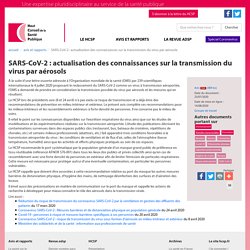
Le HCSP lors de précédents avis (8 et 24 avril) n’a pas exclu ce risque de transmission et a déjà émis des recommandations de prévention en milieu intérieur et extérieur. Le présent avis complète ces recommandations pour les milieux intérieurs et les rassemblements extérieurs à forte densité de personnes. Il ne concerne pas le milieu de soins. Il refait le point sur les connaissances disponibles sur l’excrétion respiratoire du virus ainsi que sur les études de modélisations et les expérimentations réalisées sur la transmission aéroportée. Capture d'aérosols. 90 % des contaminations se produiraient de façon aéroportée dans les lieux clos et mal ventilés. Partager un espace confiné, mal ventilé pendant une ou plusieurs heures constituerait le dénominateur commun à la grande majorité des situations propices à la contagion du Coronavirus SARS CoV-2.

Si la transmission du virus par les microgouttelettes à l’occasion d’une toux ou d’un éternuement est établie depuis le début de l’épidémie, un faisceau d’indices concordant laisse à penser que son transport aéroporté sous forme d’aérosols serait à l’origine d’un nombre tout aussi important de contaminations. 239 Experts With One Big Claim: The Coronavirus Is Airborne. The coronavirus is finding new victims worldwide, in bars and restaurants, offices, markets and casinos, giving rise to frightening clusters of infection that increasingly confirm what many scientists have been saying for months: The virus lingers in the air indoors, infecting those nearby.
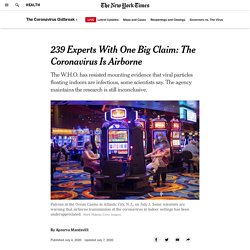
If airborne transmission is a significant factor in the pandemic, especially in crowded spaces with poor ventilation, the consequences for containment will be significant. Masks may be needed indoors, even in socially-distant settings. Health care workers may need N95 masks that filter out even the smallest respiratory droplets as they care for coronavirus patients. Ventilation systems in schools, nursing homes, residences and businesses may need to minimize recirculating air and add powerful new filters. Ultraviolet lights may be needed to kill viral particles floating in tiny droplets indoors.
Proper ventilation and N95 masks are of concern only in those circumstances, according to the W.H.O. Dr. Étude sur les environnements clos. Air conditioning may be factor in COVID-19 spread in the South. This is part of our Coronavirus Update series in which Harvard specialists in epidemiology, infectious disease, economics, politics, and other disciplines offer insights into what the latest developments in the COVID-19 outbreak may bring.
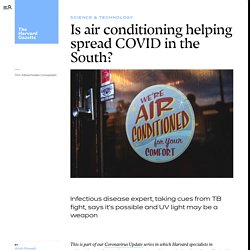
Drawing on insights from another deadly airborne disease, tuberculosis, a Harvard infectious disease expert suggested Friday that air conditioning use across the southern U.S. may be a factor in spiking COVID-19 cases and that ultraviolet lights long used to sterilize the air of TB bacteria could do the same for SARS-CoV-2. Edward Nardell, professor of medicine and of global health and social medicine at Harvard Medical School (HMS) and professor of environmental health and of immunology and infectious diseases at the Harvard T.H. Airborne transmission would make people even more vulnerable to the virus in a closed room. The lamps are set up to shine horizontally, high in the room where sterilization is needed.
The Daily Gazette. Covid-19 : contamination en chaîne dans un restaurant chinois climatisé – Réalités Biomédicales. Risque de transmission aéroportée du coronavirus SARS-CoV-2 : de l’importance du port du masque et de locaux bien ventilés – Réalités Biomédicales. It is Time to Address Airborne Transmission of COVID-19. Early Release - Case-Control Study of Use of Personal Protective Measures and Risk for Severe Acute Respiratory Syndrome Coronavirus 2 Infection, Thailand - Volume 26, Number 11—November 2020. Disclaimer: Early release articles are not considered as final versions.
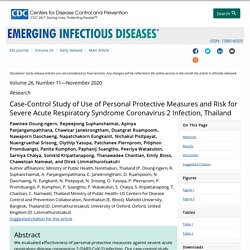
Any changes will be reflected in the online version in the month the article is officially released. Author affiliations: Ministry of Public Health, Nonthaburi, Thailand (P. Doung-ngern, R. Suphanchaimat, A. Panjangampatthana, C. Bmj.m3206. Nick Wilson, intensive care fellow, Stephen Corbett, director2, Euan Tovey, associate professor3Author affiliationsCorrespondence to: N Wilson nickwilson247@gmail.com Guidelines and governments must acknowledge the evidence and take steps to protect the public In July, 239 scientists signed an open letter “appealing to the medical community and relevant national and international bodies to recognise the potential for airborne spread of covid-19.”1 Although the World Health Organization conceded that “airborne transmission cannot be ruled out,” the response was reserved and arguably mistaken in continuing to suggest that airborne and droplet transmission are discrete categories and that airborne transmission occurs only during medical “aerosol generating procedures.”2 WHO defines droplets as ≥5-10 μm diameter and aerosols as <5 μm.

However, both can be generated as a continuum of particle sizes during numerous respiratory activities and their behaviours are not distinct. Strong signals. Viable SARS-CoV-2 in the air of a hospital room with COVID-19 patients. Airborne Spread of SARS-CoV-2 and a Potential Role for Air Disinfection. An April 2, 2020, expert consultation from the National Academies of Sciences, Engineering, and Medicine to the White House Office of Science and Technology Policy concluded that available studies are consistent with the potential aerosol spread of severe acute respiratory syndrome coronavirus 2 (SARS-CoV-2), not only through coughing and sneezing, but by normal breathing.1 This response to a White House request for a rapid review of the literature likely contributed to the recommendation from the US Centers for Disease Control and Prevention (CDC) that healthy persons wear nonmedical face coverings, when in public, to reduce virus spread from undiagnosed infectious cases.
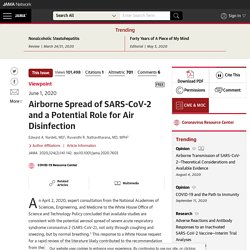
Evidence of Airborne Transmission of the Severe Acute Respiratory Syndrome Virus.